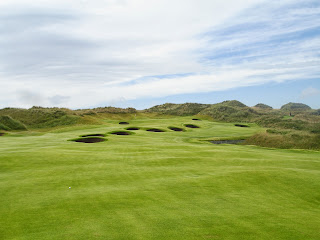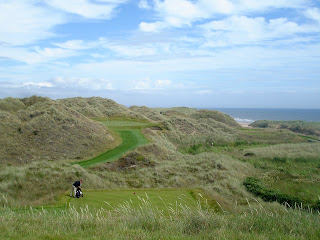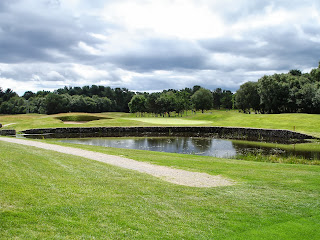When I told some of my Edinburgh-based golfing buddies that I would soon be playing a course called Glenburn, just south of the city, none of them had heard of it. One thought I meant Glencorse, or even Greenburn, a couple of excellent courses that would certainly fit the geographical description and which we've all played many times. Glenburn is in fact a 9 hole parkland course located half a mile south of the City By-Pass (the A702) between the Straiton and Lothianburn junctions. However, the course is only briefly visible from that major road and unless you played at nearby Lothianburn GC (and more about that later) or looked east when walking over the Pentland Hills to the south of Edinburgh, you'd probably not notice the course either.
 The impressive 2050 Yard Par 32 course at Glenburn was designed, built and is still owned and maintained by Tom, a local man who had previously lived in the south side of Edinburgh. Some years ago, Tom bought a house and around 9 acres of land just outside the city boundary and being a keen golfer, he decided to build a couple of golf practice holes on his land. This done, Tom realised that it might be possible to fit in some more holes and so began a remarkable project that has led to the creation of a lovely little parkland course, literally in Tom's back garden. There are 9 tees and 7 greens and in order to fit 9 holes into the site, Tom has created holes that in some cases cross each other, reminding me of the remarkable layout of the Tower of Lethendy course (see Blog entry 339). Indeed, one point on the Glenburn course is crossed by the 2nd, 3rd, 4th, 5th and 7th holes, so extreme care would be needed if the course was ever busy. Tom is happy for occasional visitors to play the course by prior arrangement but it's not generally open as a pay as you play course. Douglas, one of my golfing buddies, had arranged for us to play the course on 25 August 2013, when a small group of former pupils from an Edinburgh public school were playing it. This is me and Douglas after our round.
The impressive 2050 Yard Par 32 course at Glenburn was designed, built and is still owned and maintained by Tom, a local man who had previously lived in the south side of Edinburgh. Some years ago, Tom bought a house and around 9 acres of land just outside the city boundary and being a keen golfer, he decided to build a couple of golf practice holes on his land. This done, Tom realised that it might be possible to fit in some more holes and so began a remarkable project that has led to the creation of a lovely little parkland course, literally in Tom's back garden. There are 9 tees and 7 greens and in order to fit 9 holes into the site, Tom has created holes that in some cases cross each other, reminding me of the remarkable layout of the Tower of Lethendy course (see Blog entry 339). Indeed, one point on the Glenburn course is crossed by the 2nd, 3rd, 4th, 5th and 7th holes, so extreme care would be needed if the course was ever busy. Tom is happy for occasional visitors to play the course by prior arrangement but it's not generally open as a pay as you play course. Douglas, one of my golfing buddies, had arranged for us to play the course on 25 August 2013, when a small group of former pupils from an Edinburgh public school were playing it. This is me and Douglas after our round.
Regular readers of this blog will notice my new white Sun Mountain H2No golf bag. My familiar luminous yellow bag of the same model has been retired after doing sterling service for the past 3 years and literally hundreds of rounds. I'm not paid to do product endorsements, but if anyone is looking out for a genuinely waterproof and lightweight stand bag, look no further as in my humble opinion the H2No is simply the best. My old Cleveland Tour Edition 60 Degree wedge has also been traded in for a new Cleveland Rotex 58 Degree wedge, a long-overdue change that's already producing short-game improvements.
Anyway, back to Glenburn, which was in fantastic condition when we played it. Tom has created a fine course, requiring straight hitting off the tee and accuracy around the small greens. Tom was the perfect host, giving us a range of helpful tips on how to play his course, the main one being to avoid being long, as water hazards and/or OOB lurk immediately behind or alongside most of the holes. The 1st is a 165 Yard Par 3, played over the 6th and 7th fairways to a double green shared with the 3rd Hole. Hit anything over 170 Yards and your ball will probably finish in the stream behind the green or OOB beyond the stream. Hit it short and you're flirting with bunkers or clumps of rough. I managed an easy par after hitting my drive to 15 feet.
The 2nd is a left dog leg 303 Yard Par 4, played to a fairway that also serves the 4th. Tee shots from the 3rd, 5th and 7th also come into play so take care on these holes in particular. Assuming you've hit a decent drive, you'll be left with a semi-blind slightly uphill pitch to the 2nd green. All of the greens at Glenburn are small and anything even remotely strong to the 2nd will run off the other side, where a water hazard awaits, so be warned. I hit what I thought was a perfect pitch and ended up with a double bogey. The 3rd is a 275 Yard Par 4 played back towards the 2nd Tee to the green shared with the 1st Hole. The green is long and narrow when you play the 1st and wide and alarmingly shallow when you play the 3rd, and by now I knew that the stream and OOB awaited anything over-hit. I managed a single-putt bogey (what was I saying about my improved short game?) The 4th is a 270 Yard Par 4, with my new wedge coming to the rescue after a poor drive, helping me to a birdie.
The 5th is the longest hole on the course, at 335 Yards. The tee shot should be played towards the right side of the 1st/3rd green in the distance to set up an easy pitch to the green. I'd gone too far right, finishing in front of the 8th Tee, with a small swamp beyond that. I had 86 Yards to the flag according to my laser range finder and it was 90 Yards to the stream behind the green (with OOB immediately beyond it!) I don't do eagles very often so was delighted to see the ball drop in after a great wedge shot. From the longest hole to the shortest, the 6th is a 125 Yard Par 3. Tom hasn't set a Stroke Index for the course, but if and when he does, I suspect that the 6th will be Number 1. The inverted saucer shaped green sits atop a small hillock and is fronted by a little bunker that tempts you to go long. Do that, and you run off the back into light rough. Anything short, right or left suffers the same fate. I'd hit a pretty good 9 iron just right of the green, but my pitch then ran through (as did the return. My 4th, another short pitch, finished a foot away, so a double bogey. Tom told me later that maintaining this hole requires particular care as the green can be almost unplayable unless watered generously during dry spells. Douglas and I were just glad Tom hadn't cut the greens to their lowest as this hole would have been even more tricky. This is a view of the 6th, with the 7th green on the foreground and the 1st Tee to the left.
The Lothianburn GC clubhouse can be seen in the far distance to the right of this photo. I'd been a member of that club between 1980 and 2001 and Polly and our 2 girls had also been members there. Lothianburn opened in 1893. The current layout was designed by the great James Braid and is a hilly parkland/heathland course where we'd all enjoyed our golf over the years. I still have many friends there and have great memories of the course, the club and older friends now long gone. Sadly, the club has struggled financially in recent years and a continued membership shortage has forced the club into administration. The outlook is bleak and barring a miracle it looks as though Lothianburn will close by the turn of the year. Some of its holes may survive to form part of expanded facilities at the adjacent New Swanston GC, but this fine old course will be gone. I'm planning to play the course once more with some golfing buddies, including some who are still members and have few beers afterwards. I suspect it will be an emotional day. I might do a blog entry about Lothianburn. The club's problems are unlikely to be solved by a late flurry of visitors, but for any local readers who have not played it, please give it a go, while you can. The green fees have been reduced to £12.50, a ridiculously low figure for such a good course (see www.lothianburngc.co.uk for details).
The 7th at Glenburn is a 251 Yard Par 4, played towards our cars, as shown below. There's a little swamp to the right of the fairway, so just hit your drive straight. Anything too long beyond the green will be off the course. I had an easy par after a good drive and a 58 Degree Wedge.
The 8th is a good 180 Yard Par 3, with the green shared with the 3rd Hole. The 9th is Tom's favourite and I can see why. This hole was formerly part of a swamp and must have been a major task to build. The hole is named "The Swamp" for obvious reasons as the swamp still lies to the right of the fairway and immediately behind the green. A small bunker cut into the front of the green adds to the difficulty and at 146 Yards, this Par 3 would probably vie with the 6th as Stroke Index 1. I hit an easy 6 iron just right of the green and with Tom looking on, I rescued my par after a good chip to under a yard.
I finished with a gross 35, net 29.5, well under the course par, with a meagre 11 putts. We'd both really enjoyed Tom's course. It was a real privilege to play it, Tom, so thanks again for letting us on. Tom intends to continue to develop Glenburn, perhaps as a course where mainly hickory clubs will be used, with limited access to small groups of golfers by prior arrangement. Douglas and I wish him and his lovely little course well for the future. We hope to play it again sometime. If that happens, I hope we'll remember something about the hidden subtleties of Tom's remarkable design before tackling the course. Whether I'd eagle the 5th again is very debatable!














































